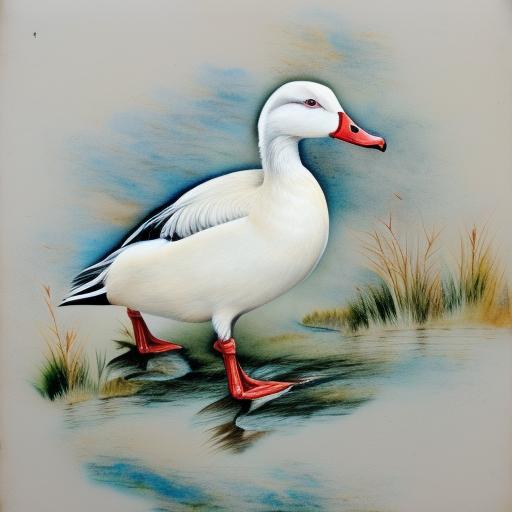White duck breeds are a popular choice for many poultry enthusiasts due to their striking appearance and gentle nature. These breeds are known for their beautiful white plumage, which sets them apart from other duck breeds. White ducks are also valued for their versatility, as they can be raised for meat, eggs, or ornamental purposes. They are often chosen for their calm and friendly demeanor, making them a great addition to any backyard flock. In this article, we will explore the characteristics, popular breeds, breeding and rearing, housing and care, and uses of white duck breeds. Whether you are a seasoned duck owner or considering adding ducks to your farm or backyard, this comprehensive guide will provide you with valuable information about white duck breeds.
Key Takeaways
- White duck breeds are popular for their unique appearance and gentle nature, making them a favorite among duck enthusiasts.
- White duck breeds are known for their distinctive white plumage, orange bills, and orange legs, which set them apart from other duck breeds.
- Some popular white duck breeds include the Pekin, White Crested, and Aylesbury, each with its own unique characteristics and traits.
- Breeding and rearing white ducks require careful attention to their diet, living conditions, and health to ensure successful reproduction and healthy offspring.
- Proper housing and care for white ducks involve providing a secure and spacious environment, access to water for swimming, and protection from predators and extreme weather conditions.
Characteristics of White Duck Breeds
White duck breeds are known for their stunning all-white plumage, which can range from pure white to a creamy off-white color. They typically have orange bills and feet, which create a striking contrast against their snowy feathers. White ducks come in various sizes, with some breeds being larger and more robust, while others are smaller and more petite. These ducks are known for their calm and gentle nature, making them an excellent choice for families with children or first-time duck owners. They are also hardy and adaptable, able to thrive in a range of climates and environments. White ducks are excellent foragers and can be raised in free-range or confined settings, making them a versatile choice for small farms or backyard homesteads.
White duck breeds are also known for their excellent egg-laying abilities. While not all white duck breeds are prolific layers, many are capable of producing a good number of large, white eggs. These eggs are prized for their rich flavor and high nutritional value, making them a popular choice for home cooks and bakers. In addition to their egg-laying abilities, some white duck breeds are also raised for meat production. These ducks are known for their flavorful and tender meat, making them a valuable addition to any small-scale poultry operation. Overall, white duck breeds are prized for their beauty, temperament, and utility, making them a popular choice for poultry enthusiasts around the world.
Popular White Duck Breeds
There are several popular white duck breeds that are favored by poultry enthusiasts for their unique characteristics and utility. One of the most well-known white duck breeds is the Pekin duck, which is prized for its large size, rapid growth rate, and excellent meat production. Pekin ducks have a distinctive white plumage and orange bill, and they are known for their friendly and sociable nature. Another popular white duck breed is the White Crested duck, which is valued for its striking appearance and distinctive crest of feathers on its head. This breed is often raised for exhibition purposes due to its unique and eye-catching appearance.
The Aylesbury duck is another popular white duck breed that originated in England. This breed is known for its pure white plumage and orange bill and feet. Aylesbury ducks are valued for their excellent meat production and are often raised for commercial purposes. The Silver Appleyard is a dual-purpose breed that comes in both white and silver varieties. These ducks are prized for their large size, excellent egg-laying abilities, and flavorful meat. Other popular white duck breeds include the Saxony, Orpington, and Indian Runner. Each of these breeds has its own unique characteristics and qualities, making them a valuable addition to any duck flock.
Breeding and Rearing White Ducks
Breeding and rearing white ducks can be a rewarding experience for poultry enthusiasts who are interested in raising these beautiful birds. When breeding white ducks, it is important to select healthy, high-quality breeding stock with desirable traits such as good conformation, strong egg-laying abilities, and gentle temperament. It is also important to provide ducks with a clean and comfortable environment that meets their nutritional needs to ensure successful breeding and healthy offspring.
When rearing white ducklings, it is essential to provide them with a warm and secure brooding area equipped with heat lamps or brooders to maintain the appropriate temperature. Ducklings should be fed a high-quality starter feed that is specifically formulated for waterfowl to support their rapid growth and development. It is important to provide ducklings with access to clean water for drinking and swimming from an early age to encourage healthy growth and development.
As white ducks mature, it is important to provide them with ample space to roam and forage while also protecting them from predators and the elements. Proper nutrition, access to clean water, and regular health checks are essential for maintaining the health and well-being of white ducks throughout their lives.
Housing and Care for White Ducks
Proper housing and care are essential for the health and well-being of white ducks. When housing white ducks, it is important to provide them with a secure and predator-proof shelter that offers protection from the elements. The shelter should be well-ventilated and spacious enough to accommodate the number of ducks in the flock comfortably.
White ducks also require access to clean water for drinking and bathing. A shallow pond or kiddie pool can provide ducks with the opportunity to engage in natural behaviors such as swimming and foraging for aquatic plants and insects. It is important to regularly clean and refill the water source to prevent the buildup of bacteria and algae.
In addition to water access, white ducks require a balanced diet that meets their nutritional needs. A high-quality commercial feed formulated specifically for ducks can provide essential nutrients such as protein, vitamins, and minerals to support their overall health and well-being. Ducks should also have access to fresh greens, vegetables, and occasional treats such as mealworms or cracked corn to supplement their diet.
Regular health checks are essential for monitoring the well-being of white ducks. It is important to observe ducks daily for any signs of illness or injury and seek veterinary care if necessary. Providing proper housing, access to clean water, a balanced diet, and regular health checks are essential components of caring for white ducks.
Uses of White Duck Breeds

White duck breeds have a variety of uses that make them valuable additions to small farms, homesteads, and backyard flocks. One of the primary uses of white duck breeds is egg production. Many white duck breeds are prolific layers capable of producing large, flavorful eggs that are prized by home cooks and bakers. Duck eggs are known for their rich flavor and high nutritional value, making them a popular choice for culinary purposes.
In addition to egg production, some white duck breeds are raised for meat production. Ducks raised for meat are valued for their flavorful and tender meat that can be used in a variety of culinary applications. Duck meat is prized for its rich flavor and versatility in cooking, making it a valuable addition to small-scale poultry operations.
White duck breeds are also valued for their ornamental qualities. Many poultry enthusiasts raise white ducks for exhibition purposes due to their striking appearance and unique characteristics. White ducks can be showcased at poultry shows or fairs where they are judged based on breed standards such as plumage color, conformation, and temperament.
Overall, white duck breeds have a variety of uses including egg production, meat production, ornamental purposes, and as friendly additions to backyard flocks. Their versatility, beauty, and gentle nature make them a popular choice for poultry enthusiasts around the world.
Conclusion and Considerations for White Duck Ownership
In conclusion, white duck breeds are prized for their striking appearance, gentle nature, and versatility in egg and meat production. Popular white duck breeds such as the Pekin, Aylesbury, White Crested, Silver Appleyard, Saxony, Orpington, and Indian Runner offer unique characteristics that make them valuable additions to any poultry flock. When considering ownership of white ducks, it is important to provide proper housing, care, nutrition, and veterinary attention to ensure the health and well-being of these beautiful birds.
Whether you are interested in raising white ducks for egg production, meat production, exhibition purposes, or as friendly additions to your backyard flock, these birds have much to offer in terms of beauty, utility, and companionship. With proper care and attention, white duck breeds can thrive in a variety of environments while providing valuable resources such as eggs and meat. Consider adding white ducks to your farm or backyard flock to enjoy the many benefits that these beautiful birds have to offer.
If you’re considering raising white duck breeds, it’s essential to understand their dietary needs. Poultry Wizard offers a comprehensive article on what to feed ducks, providing valuable insights into the nutritional requirements of these beautiful birds. Understanding the right diet for your ducks is crucial for their health and well-being. Check out the article here to ensure you’re providing the best care for your white duck breeds.
FAQs
What are some common white duck breeds?
Some common white duck breeds include the Pekin, the White Crested, the Aylesbury, and the White Campbell.
What are the characteristics of white duck breeds?
White duck breeds typically have a white plumage, orange bills and feet, and a medium to large size. They are known for their calm and friendly temperament.
What are white duck breeds commonly used for?
White duck breeds are commonly used for meat production, egg laying, and as ornamental or exhibition birds. They are also popular for pest control in agricultural settings.
How do you care for white duck breeds?
White duck breeds require access to water for swimming and bathing, a balanced diet of commercial duck feed and fresh greens, and protection from predators. They also need regular veterinary care and shelter from extreme weather conditions.
Are white duck breeds good for beginners?
White duck breeds can be a good choice for beginners due to their calm and friendly nature. However, they still require proper care and attention to thrive.
Meet Walter, the feathered-friend fanatic of Florida! Nestled in the sunshine state, Walter struts through life with his feathered companions, clucking his way to happiness. With a coop that’s fancier than a five-star hotel, he’s the Don Juan of the chicken world. When he’s not teaching his hens to do the cha-cha, you’ll find him in a heated debate with his prized rooster, Sir Clucks-a-Lot. Walter’s poultry passion is no yolk; he’s the sunny-side-up guy you never knew you needed in your flock of friends!







